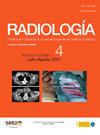Papel de la resonancia magnética de difusión en el diagnóstico inicial de los tumores de partes blandas
IF 1.1
Q3 RADIOLOGY, NUCLEAR MEDICINE & MEDICAL IMAGING
引用次数: 0
Abstract
Background
Soft tissue tumours (STT) constitute a heterogeneous group of lesions frequently studied by Magnetic Resonance Imaging (MRI). It has not yet been clearly established whether the inclusion of apparent diffusion coefficient (ADC) diffusion-weighted imaging (DWI) maps would better determine tumour aggressiveness.
Purpose
To assess the diagnostic value of quantitative ADC DWI maps in the initial diagnosis of STT; and to determine whether the inclusion of DWI provides more valuable information than conventional sequences alone.
Material and methods
Retrospective study of patients with histologically proven STT. Conventional morphological MRI sequences and the DWI sequence were analysed. The ADC was quantified using a region of interest (ROI) that covered the largest sectional area (global ADC) and another that selected the area of greatest restriction (selected ADC). Differences in ADC values were analysed between both benign and malignant lesions and high and low-grade sarcomas. A multivariate analysis was performed to determine the ability of ADC to adequately diagnose the nature of STTs when associated with other morphological characteristics.
Results
84 patients with STT, of which 40 were benign and 44 malignant. The malignant group included 10 low-grade sarcomas, 23 high-grade sarcomas, 4 non-sarcomatous neoplasms and 7 sarcomas with no histological grading. The ADC values were significantly higher in benign lesions for the selected ADC. Significantly higher selected ADC values were also obtained in low-grade sarcomas. In the multivariate analysis, the highest diagnostic precision values were obtained when morphological features and ADC were included, with a sensitivity, specificity, and area under the curve (AUC) of 84, 75 and 91%, respectively.
Conclusion
The inclusion of ADC DWI values improves the diagnostic accuracy of MRI for STTs, especially when used in combination with conventional MRI sequences.
弥散磁共振成像在软组织肿瘤初步诊断中的作用
背景:软组织肿瘤(STT)是磁共振成像(MRI)经常研究的一组异质性病变。目前尚不清楚是否包括表观扩散系数(ADC)扩散加权成像(DWI)图能更好地确定肿瘤的侵袭性。目的评价定量ADC DWI图在STT初诊中的诊断价值;并确定包含DWI是否比单独的常规序列提供更有价值的信息。材料和方法对组织学证实的STT患者进行回顾性研究。分析常规形态学MRI序列和DWI序列。使用覆盖最大截面积(全局ADC)的兴趣区域(ROI)和选择最大限制区域(选定ADC)的兴趣区域(ROI)对ADC进行量化。分析了良、恶性病变和高、低分级肉瘤之间ADC值的差异。我们进行了多变量分析,以确定ADC在与其他形态学特征相关联时充分诊断stt性质的能力。结果84例STT,其中良性40例,恶性44例。恶性组包括低级别肉瘤10例,高级别肉瘤23例,非肉瘤性肿瘤4例,无组织学分级的肉瘤7例。良性病变的ADC值明显高于所选ADC值。在低级别肉瘤中,选择的ADC值也明显更高。在多因素分析中,包括形态学特征和ADC的诊断精度值最高,灵敏度、特异性和曲线下面积(AUC)分别为84%、75%和91%。结论纳入ADC DWI值可提高MRI对stt的诊断准确性,特别是与常规MRI序列结合使用时。
本文章由计算机程序翻译,如有差异,请以英文原文为准。
求助全文
约1分钟内获得全文
求助全文
来源期刊

RADIOLOGIA
RADIOLOGY, NUCLEAR MEDICINE & MEDICAL IMAGING-
CiteScore
1.60
自引率
7.70%
发文量
105
审稿时长
52 days
期刊介绍:
La mejor revista para conocer de primera mano los originales más relevantes en la especialidad y las revisiones, casos y notas clínicas de mayor interés profesional. Además es la Publicación Oficial de la Sociedad Española de Radiología Médica.
 求助内容:
求助内容: 应助结果提醒方式:
应助结果提醒方式:


